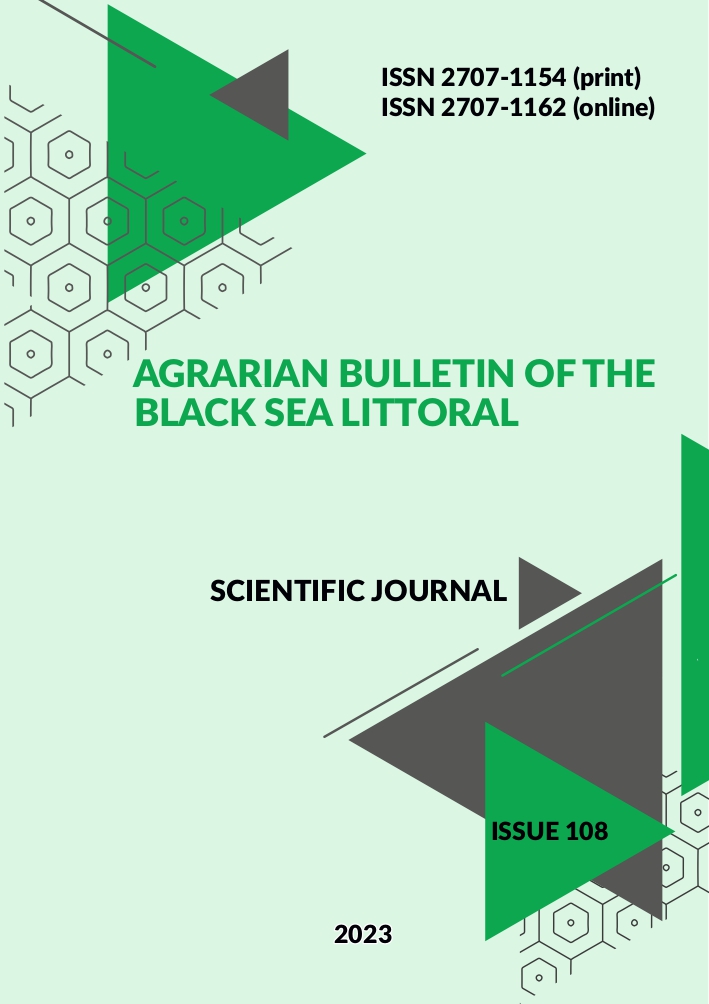Disinfection in the livestock building
DOI:
https://doi.org/10.37000/abbsl.2023.108.10Keywords:
pigs, disinfection, disinfectant, livestock buildings, sectionAbstract
The aim of the study was to investigate the effect of two types of disinfectants used for aerosol disinfection in livestock buildings.
The effectiveness of disinfectants used for aerosol disinfection in livestock premises was determined, microclimate parameters in the premises where pigs are kept for fattening and their productivity were studied.
Zoohygienic and clinical and physiological methods were used to determine the effect of complex disinfectants.
It was found that the use of dry disinfectant «Virkon S» with an exposure of 30 minutes at a dose of 300 ml\m2, when fattening pigs indoors, contributed to the improvement of productivity, preservation of livestock, and also created the possibility of reducing the incidence of gastrointestinal and respiratory diseases in pigs in the experimental section compared to the control one. It was determined that according to the results of the study, «Virkon S» effectively showed a bactericidal effect, the total bacterial contamination decreased by 95.1 %, the concentration of ammonia in the air decreased by 58.4 % compared to the initial data. Our proposed agent was much more effective and safer than Stalosan F. The results confirm the feasibility of using the complex disinfectant «Virkon S» in the system of veterinary and sanitary measures for disinfection in the presence of animals.
References
Бабайкін В. Дезінфекція – надійний захід профілактики захворювань молодняку Ветеринарна медицина України. 1997. С. 4-5.
Бусенко О. Т. Технологія виробництва та продукції тваринництва. Підручник. Київ. 2001. С. 219-221.
Герасимов В. І., Барановський Д. І., Хохлов А. М. Технологія виробництва продукції свинарства: навч. посібник. Харків. 2010. С. 7, 12-14.
Голуб Ю. С. Проблеми сучасної дезінфекції. Ветеринарна медицина України. № 4. 2011. С. 26-30.
Дмитрук Б. П., Клименко Л. В. Виробничий цикл у галузі свинарства: національний та світовий досвід. Київ. 2006. С. 14-15.
Завгородній А. І. та ін. Ефективність дезінфекції залежно від якості проведення механічного очищення. Ветеринарна медицина України. 2012. С. 5, 8-10.
Коваленко В. Л., Недосєков В. В. Концепція розробки та використання комплексних дезінфектантів для ветеринарної медицини. Монографія. Київ. 2011. С. 117-121.
Косенко М. В., Сергіенко О. І., Авдосьева І. К. та ін. Ефективність нового дезінфікуючого засобу «Дезокс». Матер. ІІ міжнар. симп. з питань гігієн. тв. 1996. С. 82-85.
Коцюмбас І. Я. та ін. Сучасні засоби ветеринарної дезінфекції. Ветеринаринарна медицина України. 2010. С. 11, 36–26.
Якубчак О. М. Ветеринарна дезінфекція. Інструкція та методичні рекомендації. Київ: «Компанія Біопром». 2010. С. 76-84.
Якубчак О. М. Чим краще обробити? Порівняльна оцінка сучасних і традиційних дезінфекційних засобів, що використовуються в галузі птахівництва. Сучасне птахівництво. 2006. С. 6, 14–15.
Ященко М. Ф. Санітарно-гігієнічні заходи – основа профілактики інфекційних захворювань свиней. Зб. матеріалів Міжнародної наук.-практ. конф. Львів, 1997. С. 250–251.
Yannalopoulos, A. L, Tserveni-Gousi, A. S., Christaki, EEffect of natural zeolite ony olk: albumen ratioin heneggs. Brit. PoultrySc. 1998. С. 506–510.
USDA APHIS. Foreign Anima lD isease Prepared ness and Response Plan (FAD PReP). Cleaning and Disinfection Guidelines. 2014. С. 44-45.
FAD PReP/NAHEMS Guidelines: Cleaning & Disinfection. 2014. С. 7-9.


